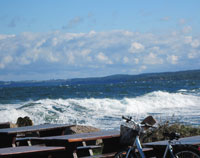In Denmark, it is possible to combine the atmosphere of buzzing city life with the relaxation of beautiful Danish countryside, clean beaches, and green forests, all within a short distance from each other. The country is relatively flat, with the highest point rising to only 173 m. About 65% is farmland, 11% woodland, and the rest is built-up areas, roads, and lakes. The winters are wet, with some snow. The temperature falls to -10°C in the winter.
Landscape

The landscape is characterized by well-cultivated fields, hedges, earth and stone walls, and scattered woods. Large forests are rare. Small towns, farms, and houses lie strewn across the scenery, connected by a finely woven communications network. The scattered agricultural habitation is characteristic of Denmark. The lines of field boundaries and other perimeters are sharp, often completely straight; untended areas have before been rare. However, Denmark now has 5 national parks and several nature parks where the local plant and animal life is allowed to develop on its own. Some natural species, such as moose, have also been reintroduced into the wild.
Children
Danish children roam freely and safely, and Copenhagen offers excellent living conditions based on a wide range of factors including education, health, economy, social conditions, culture, and welfare. According to international studies, Denmark has one of the highest living standards in the world. Danes enjoy a high quality of life, a rich cultural profile, a safe, well-functioning society with no corruption, and a high level of public services.
Population
The population numbers 5.5 million people, and the population density is 120 people per square kilometer. The capital is Copenhagen with around 1.2 million inhabitants, and it is a delightful place to visit or live and enjoy an old, historical city center and a large network of pedestrian streets, bicycle paths, and parks.
Language
The official language is Danish, and most people understand and speak English. The number of immigrants has doubled over the past 20 years and is now 5% of the population. The possibilities to learn Danish in Denmark are vast. The courses are run as regular courses during the year, intensive short-term courses, and as summer courses during the holidays.
State
Denmark is a modern welfare state, and a constitutional monarchy with a record of kings and queens dating back to year 1000 exist. A democratically elected government and a parliament govern the country. Many political parties are represented in parliament, often as many as 10 to 15 parties. Denmark has a high standard of social security and free public services, including a high quality educational sector. The Danes pay one of the highest tax rates in the world in order to make these services possible.
International Commitment
Denmark has a strong international commitment as a member of the European Union, the Nordic Council, the United Nations, and NATO. Denmark has been a member of the European Union since 1973, but the population is divided into two equally sized blocs of pro and con. In 1993, the Maastricht Treaty allowed Denmark four opt-outs of the Union in areas such as common defense policy and union citizenship. The opt-outs can only be renounced by a referendum, and in 2000, Denmark voted against participation in the European Monetary Union at a referendum. The Danish currency therefore remains kroner, DKK, though it is linked to the Euro.
Industry
Industry has accounted for the major part of exports since 1963. North Sea oil and natural gas are increasingly important to the economy, as are biotechnology and information technology. A very high percentage of women are active on the labor market, and the unemployment rate has been relatively low since the mid 1990's.
Education
The educational level of the population is high with 77% completing a vocationally qualifying education. Tuition is free, and there are nine years of compulsory education. Public expenditure on education and training corresponds to 7% of the country's GDP and around 13% of total public expenditure.
Workforce
The Danish workforce is among the most productive in Europe and one of the top two countries in Europe when it comes to competitive salary levels for professionals and management. The Copenhagen labor market is the largest in Scandinavia, and because it is the educational center of Denmark, a large part of the population in the region has a higher education degree.
Excellent foreign language skills, flexible labor regulations, and a strong public security system among others, make Copenhagen attractive from a labor market point of view. In Denmark, the normal working week consists of 37 hours spread out on a five-day week. However, the collective agreements make it easy to adjust working hours to meet unexpected changes in demand. In regard to holidays, 10 paid public holidays are observed. In addition, all employees have the right to 25 days of vacation every year.
Taxes
The Danish corporate tax is 28%, placing it below the average European level. There is no additional local tax, franchise, or net wealth tax. Corporate tax is paid after deduction of expenses. Social security is, to a very large extent, financed indirectly through taxes rather than directly by employees or employers.
When it comes to income tax, Denmark and the other Scandinavian countries are generally considered a high tax area. Typically, individuals pay between 45% and 55% in income tax. This level of income tax reflects a high level of welfare. The Danish welfare model is based on the principle that different population groups enjoy decent living conditions and equal opportunities in terms of education and social welfare. Health care, education, elderly care, and kindergartens for children are, to a very large extent, financed through taxes and provided by the public sector.
Click here for more information about Denmark and how to visit